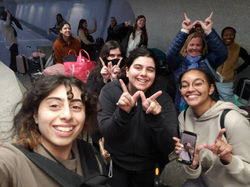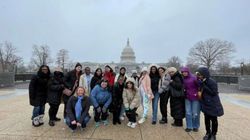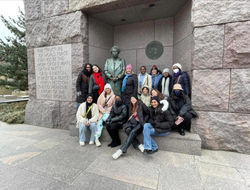

diplomat for a day
 |  |
|---|---|
 |
Regarding my co-curricular activity, I chose the time I was selected to be a diplomat for a day and shadow the U.S. Embassy in Qatar’s Deputy Chief of Mission, Natalie A. Baker. This was done in honor of International Women’s Day where female political students and ambassadors were celebrated and allowed to interact and both inform and learn about each other’s political missions and roles in empowering women.
Learning about the different sections within the U.S. Embassy made my own vision of what seemed unfeasible, in terms of being a female who can obtain an official position in political participation, more within reach and deeply understood in comparison to my surface-level view of what it takes to be a politician. In fact, it was this event that inspired my entire CMAP topic since I met many women who were involved in politics that day, and I began to wonder what challenges they may have faced in being politically active as women. I got a firsthand insight into the environment of diplomacy and political participation, centering on gender equality and the empowerment of women in politics since every section of the embassy that I visited, from the consular section and FBI to public diplomacy, women were everywhere to be seen holding positions and being heavily involved and successful in their field. They were extremely knowledgeable about ensuring security within society, the economic state of Qatar, and how to solve whatever obstacle American citizens may encounter. I got to meet the various types of female political participants themselves who showed me that there’s more than one way to contribute politically. In terms of media, I came to learn that the public diplomacy section heavily relies on the media and plays a role in producing media content for the U.S. Embassy and the events they host. The women who I met and work in this section even consist of Lebanese American women, like myself, portraying the multicultural coexistence of women’s participation in media and politics. This resonated with me since I find myself in the same position of a shared identity. Especially in the position of managing the media, women can empower female politicians, and this is apparent from the U.S. Embassy’s social media. This immersive experience not only provided me with a unique perspective on the interaction of media representation and female political participants, but it also inspired me and other fellow diplomats for a day to advocate and believe in the attainment of gender equality in the political field, and this is extremely important as we are all foreign affairs students who are about to pave their path into the political arena. It was a great opportunity and initiative that strived in the direction of equality and empowerment. It really was inspiring and immensely a pleasure and beneficial at the same time, to meet such great, hardworking, and successful women who pushed beyond boundaries, making way for the rest of the women who aim to follow.

women as changemakers
 |  |  |
|---|---|---|
 |  |
The Women as Changemakers trip was a trip like no other. It was one of those learning journeys where you really have to live it to learn it. It is different when you meet the female changemakers in person and hear about their experiences. I got to meet some of the most influential women across several domains such as social justice, athletics, and economics. A female political participant and changemaker that I met was Ambassador Melanne Verveer, Executive Director of the Georgetown Institute for Women, Peace and Security (GIWPS). She is a changemaker who heavily resonates with my topic since she is an advocate for specifically the increase of women's participation in politics and was a leader in the development of the U.S. National Action Plan on Women, Peace, and Security. She also worked under President Obama who appointed her as the U.S. Representative to the UN Commission on the Status of Women. She is the epitome of what empowerment of female political participation represents.
Additionally, I was surprised to find that my CMAP topic relates to a large amount of the work that I have done over the years. Coincidentally, I found that I wrote a segment for the e-portfolio called "The Politics of Representation: Change-making Beyond Tokenism," which reads as follows:
"Regarding women's representation, it is crucial to acknowledge that there are still significant gender disparities in many fields and contexts worldwide. Women are underrepresented in positions of power, including in parliament, the corporate world, and other leadership roles (even though we met some amazing women who have a role in each of the fields mentioned). Women's representation is not only about having women in the room, but also about ensuring that they have a voice and can influence decisions.
In terms of representation, there can be two types: "portrait" representation, which is simply having women present in a group, and "proxy" representation, where women have real power and influence. Unfortunately, in many contexts, women are present only in portrait representation, without real decision-making power or influence.
During my time in this trip, I have learned that listening to women's voices and experiences is essential in improving their representation and ensuring they have a say in decision-making processes. It is crucial to address the systemic barriers that women face, such as gender bias and discrimination, lack of support for work-life balance, and limited access to education and resources. One lesson that can be applied to improve women's presence and voice is to create an environment that is inclusive of diverse perspectives and encourages collaboration. This could involve promoting policies and practices that foster gender equality and diversity, including mentorship programs, flexible work arrangements, and diversity and inclusion within the workforce.
In summary, it is crucial to recognize the importance of both portrait and proxy representation of women and to create an environment that values and encourages diverse perspectives and collaboration. By listening to women's voices and addressing systemic barriers, we can work towards achieving greater gender equality and representation in all fields and contexts."

.png)
lebanese movie night








Some of my artworks that relate to this co-curricular activity
This piece portrays Lebanon as a female crying through the flames as the Lebanese Revolution ensues
This piece portrays downtown in Beirut where a mosque and a church are located near each other, symbolizing religious diversity and harmony.
As the founder and president of the Lebanese club at Georgetown, I have hosted many events that exhibit Lebanon's culture, history, economics, and politics. One key event that relates to my CMAP topic is the Lebanese Movie Night where I chose the film "Where Do We Go Now?" by Nadine Labaki, a well-known Lebanese director and actress who has done several of the most famous Lebanese films known today. "Where Do We Go Now?" is a film that discusses the sectarian tension and violence present in Lebanon. It depicts men always getting into an altercation or starting a war due to religious conflict. This resulted in the death of an innocent boy who was caught in the crossfire of the shootout. Hence, the women who were tired of seeing their men die or go off to another war due to religious tensions decided to put an end to it. The women gathered and planned to distract the men one night and take all of their guns. They buried all of their guns far away and the next day, the women surprised the men by following the opposite religion and putting themselves in the other's shoes. They took a stand and became the powerhouse of the village, ending all religious misunderstanding, tension, and violence. The message of this movie portrays that women were the solution, the strategists, and the strong force in the political, social, and religious sense. It paints women as initiators of peace and harmony, something that all parts of the world still need to this day, and can be better achieved with the incorporation of women into the political field. This dedication to the female effort is best seen in the ending of the film (depicted in the pictures above) that says, "To our mothers," and in the last scene, as they were carrying the casket of the innocent boy who died, the film mentions that it was a "tale of women, still in black, who fought with flowers and prayers instead of guns and flares."